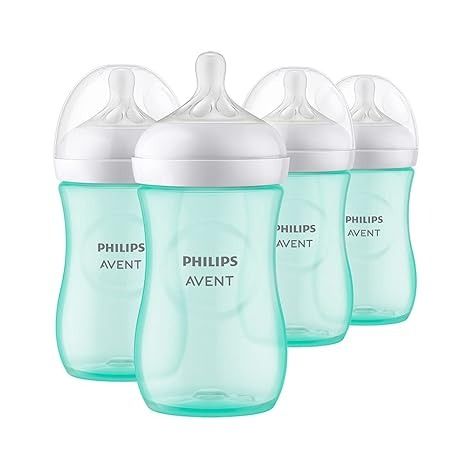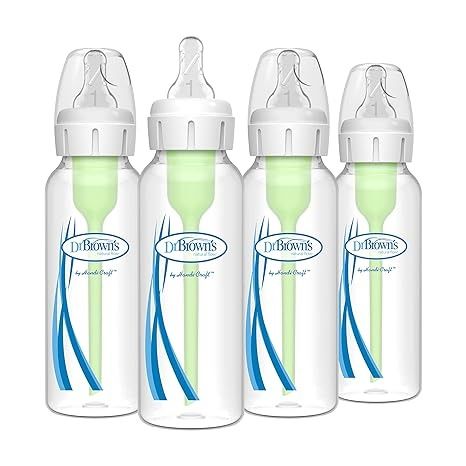[ad_1]

Philips Avent Natural
$25 $31 Save $6
The Philips Avent Natural baby bottle replicates the feeling of nursing. With a nipple that controls the rate of flow and only activates when baby feeds, this top choice among parents will feel more like breast feeding than drinking from a bottle. Along with a natural flow, the nipple features a no-drip design that eliminates breast milk or formula losses and an anti-colic valve to reduce gassiness and fussiness.
Pros- Natural Response nipple flow
- Anti-colic valve
- Natural latch nipple

Dr. Brown’s Natural Flow Options
Dr. Brown’s Natural Flow Options baby bottle features a sleek narrow glass design and a vacuum-free nipple that offers a constant flow. With an anti-colic vent system, this bottle helps to preserve precious nutrients from pumped breast milk or formula and reduces spit-up, gas, and burping after baby feeds.
Pros- Natural feeling nipple design
- Anti-colic vent
- Encourages natural latch
Whether you supplement with formula, strictly bottle feed, or need someone else to feed baby your breast milk while you’re away, knowing which bottle to choose is a top priority. While it might seem like every bottle serves the same purpose, different brands have features that may make it easier (or more challenging) for your baby to feed naturally.
Enter the Philips Avent Natural and Dr. Brown’s Natural Flow Anti-Colic Options baby bottles. These two top choices are popular picks among parents– with tens of thousands of Amazon ratings and almost five stars each. That’s why we’re pitting these brands against one another in a head-to-head bottle battle! From nipple shape and material make-up to ease of flow and even eco-friendliness, we’ve done the research for you and have the details on features that impact how you feed your baby.
So, what’s the difference between these two bottles – and which one is better for your baby? Let’s take a look.
Prices and specs
Both of these bottles are similarly priced. While neither option is shockingly expensive, they both do fall at the upper edge of the baby bottle spectrum. Even though these bottles may seem pricey, they do come in a four-pack and the features each one offers do make them worth the price. Combined, the quantity of bottles you get in one set and the quality of the products make the Avent Natural and Dr. Brown’s Options values for the cost.

Philips Avent Natural
$25 $31 Save $6
The Philips Avent Natural baby bottle replicates the feeling of nursing. With a nipple that controls the rate of flow and only activates when baby feeds, this top choice among parents will feel more like breast feeding than drinking from a bottle. Along with a natural flow, the nipple features a no-drip design that eliminates breast milk or formula losses and an anti-colic valve to reduce gassiness and fussiness.
- Material
- Polypropylene bottle and silicone nipple
- BPA-Free
- Yes
- Bottle Capacity
- 9 oz.
- Dishwasher-Safe
- Yes
- Brand
- Philips

Dr. Brown’s Natural Flow Options
Dr. Brown’s Natural Flow Options baby bottle features a sleek narrow glass design and a vacuum-free nipple that offers a constant flow. With an anti-colic vent system, this bottle helps to preserve precious nutrients from pumped breast milk or formula and reduces spit-up, gas, and burping after baby feeds.
- Material
- Glass bottle and silicone nipple
- BPA-Free
- Yes
- Bottle Capacity
- 8 oz.
- Dishwasher-Safe
- Yes
- Brand
- Dr. Brown’s
Nipple and feeding features
Baby bottles serve one purpose – to feed your infant. But the technology, design, and delivery methods vary by brand and bottle. The Philips Avent Natural uses a “Natural Response” nipple that acts like and is shaped like the human breast. Instead of a constant flow, the Avent’s nipple only releases liquid when the baby actively drinks from it. The breast-like response may make it easier to switch back and forth between nursing and bottle feeding if necessary.
The Dr. Brown’s bottle also uses a nipple that mimics breastfeeding. The silicone nipple is vacuum-free, allows a constant flow, and is shaped to encourage a proper latch. Like the Avent Natural, this top pick is also a winner when it comes to switching back and forth between the breast and the bottle. Both bottles also offer different nipple levels for a slower or faster flow rate.
Along with the breast-like flow, both bottles have an anti-colic valve or vent. This helps to reduce gas, spit-up, and the related tummy troubles. Overall, when it comes to feeding features, both of these top baby bottles provide plenty of real breast-like nursing motion, different flows based on nipple size/level, and an ant-colic feature.
Eco-friendly features
The Philips Avent Natural and Dr. Brown’s Options aren’t just baby-friendly. These top bottles are also eco-friendly. If you’re looking to help the planet, the Avent bottle is GreenCircle Certified as a product with a reduced carbon footprint (during the manufacturing process).
Dr. Brown’s Options is another green choice. This Earth-conscious brand collaborates with PlasticBank to reduce the amount of plastic used on the planet. This glass bottle eliminates the need for extra plastic use. The Anti-Colic Options also includes a removable vent that eliminates the need to buy additional bottles as your baby grows and their feeding needs change. This means you won’t have to toss the bottle and invest in new ones. So, if eco-friendliness is a primary perk you’re looking for, the Dr. Brown’s bottle may win out.
How can you safely clean your baby bottles?
Keeping your baby’s bottles clean is a top priority. And, a simple rinse after feeding just won’t do. Always follow the manufacturer’s directions for safe cleaning practices. Inspect the nipples, body of the bottles, and other parts regularly for signs of wear, tear, or debris buildup.
The U.S. Centers for Disease Control and Prevention (CDC) recommends cleaning bottles after every feeding. The CDC notes that you should throw away formula that is not used within two hours to reduce the risks of bacterial growth. After your baby is done with their meal, take the bottle apart completely. This allows you to clean the valves, vents, rings, and other parts fully. Both the Avent and Dr. Brown’s bottles are dishwasher safe. If you don’t have a dishwasher or don’t have time to do a full load, fill a clean basin with soapy hot water. Invest in a high-quality bottle brush to scrub the inside of the bottle, the nipple, and the other parts. Make sure to squeeze water through the hole at the end of the nipple.
After hand washing the bottle, rinse it thoroughly. Keep the parts separated and let them fully air dry before using the bottle again. The American Academy of Pediatrics (AAP) cautions parents and caregivers to always wash their hands before handling baby’s clean bottles. This can help to prevent cross-contamination.
Use a bottle sterilizer or boiling water to sterilize bottles. Glass bottles, such as Dr. Brown’s, typically require sterilization after each use.
So which is right for you: Avent or Dr. Brown’s?
With similar price points and features, it doesn’t look like there’s a clear winner between the two choices. This means it all comes down to personal preference – yours and your baby’s. The Avent has a slightly curved design that some babies may prefer to grapes, while the Dr. Brown’s bottle is straighter and made of glass. If you’re not sure which bottle your baby will accept and use more readily, try them both. You may notice that your little one likes one more than the other or ends up enjoying the bottles equally!
[ad_2]

